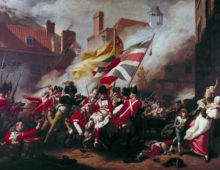Tagged with Trade
Resource : Locomotion No. 1
This is the first steam powered railway engine to run on a public railway. It was designed by George Stephenson and sparked a transport revolution that transformed the lives and fortunes of people across Britain and the wider world.
Resource : Description of a Slave Ship
Transatlantic slavery was a brutal system which forcibly shipped over twelve million Africans to the Americas and lasted over 300 years. It allowed African men, women and children to be stolen from their homeland, bought and sold as property and used to produce sugar, coffee, cotton and other goods for huge profit in the European and North American markets. This print was made to highlight the inhumane conditions under which enslaved Africans were transported across the Atlantic Ocean, forced to make the long voyage from West Africa to the Americas, tightly packed into the hold of ships and held in chains.
Resource : “Waterloo Teeth”
This set of dentures is fitted with real human teeth, extracted from the mouths of dead soldiers.
Resource : Cotton kerchief (headwrap)
The headwrap originated in sub-Saharan Africa. For centuries, it has been worn by women in different African countries and regions, in different forms, to reflect both communal and personal identities – which clan or tribe they belonged to, whether they were married, widowed, young or old, for example. This cotton kerchief, or headwrap, belonged to Nancy Burns (1800 – 1849). Born in Albany, New York, the daughter of slaves, she would eventually find work as a house servant and was painted in a portrait wearing the item in the 1840s. It represents a long history of cultural identity associated with women of African origin – particularly African-American women – that is still very much alive today.
Resource : ‘No Stamp Act’ teapot
In the 1700s, a large area of North America was controlled and governed by Britain. In 1765, the British government changed the tax rules for the people living in these American colonies. Large numbers of colonial Americans refused to pay these taxes, complaining they had no representation in the British Parliament and therefore no say over decisions made about their lives. A period of unrest followed which escalated into the American Revolution and the birth of the USA.
Resource : Drawer handle with abolitionist plaque
In the late 1700s, the image of a kneeling, enslaved African man, accompanied by the words ‘Am I not a man and a brother’ became the most prominent emblem for those wishing to abolish the Transatlantic slave trade, in both Britain and America. As well as appearing in books, prints and pamphlets, it was also reproduced on an extraordinary variety of everyday and household items – from crockery and soft furnishings, to jewellery and hairpins.
Resource : William Wilberforce speaking out against slavery in the House of Lords
The movement to abolish the Transatlantic slave trade was a long and difficult struggle. Campaigners for abolition used every means they could, including sugar boycotts, meetings, petitions, publications, and circulating images showing its shameful nature, to bring the issue to people’s attention in Europe. Enslaved Africans played an essential part, having long resisted their enslavement and treatment through ‘go-slows’, revolts, intellectual and religious claims, and demonstrable capacity to retain and transmit their African or creole (mixed) cultures and languages. Escaped or freed slaves forced judges and social elites to confront the issue through court cases, publications, and performances. Propelled by much of this pressure and evidence, William Wilberforce led the long political campaign to outlaw the slave trade in Britain.
Resource : Thomas Clarkson’s campaign chest
Between the 1500s and early 1800s, millions of Africans were kidnapped, sold and transported to the Americas to work as slaves, in unimaginably cruel conditions, on hugely profitable plantations, producing sugar, tobacco and other commodities. These plantations were largely owned by Europeans and Euro-Americans. Britain grew rich on the profits from this transatlantic slave trade, which were reinvested into other economic sectors. Only in the late eighteenth century did public opinion slowly begin to turn against the trade in Africans, and campaigners for abolition used every way they could to bring the issue to people’s attention in Europe.
Resource : Captured Africans
Kevin Dalton Johnson’s Captured Africans is a memorial to enslaved Africans transported on ships originating out of Lancaster as part of the Transatlantic slave trade. It stands on St George’s Quay in Lancaster and was unveiled in 2005.
Resource : Textile sample books
Cotton was one of the latest textile fibres to be introduced to Britain as a raw material within a manufacturing system, but between the eighteenth and nineteenth centuries it rose to prominence as a cornerstone of the British economy. Cotton manufacture stimulated industrialisation, global commercial influence, and new communities of labour. This is one of five early sample books illustrating the cotton and calico designs produced by the textile industry in Salford between 1769 and 1851.


